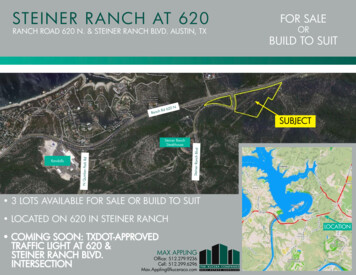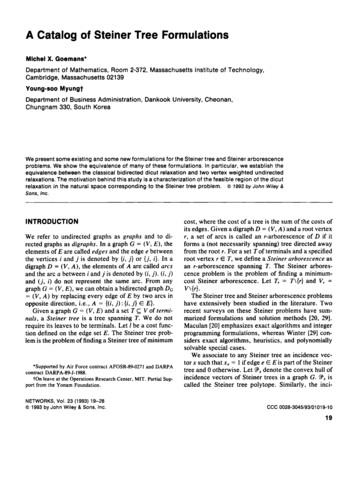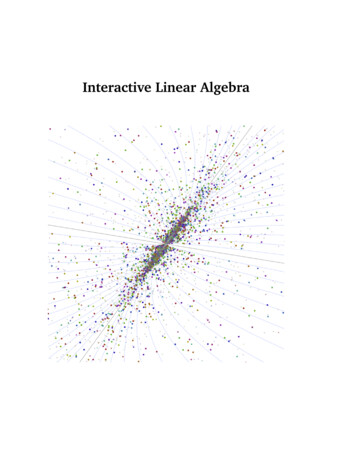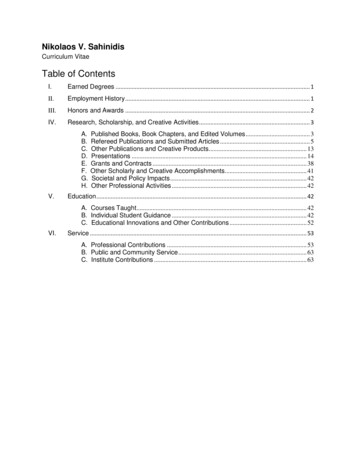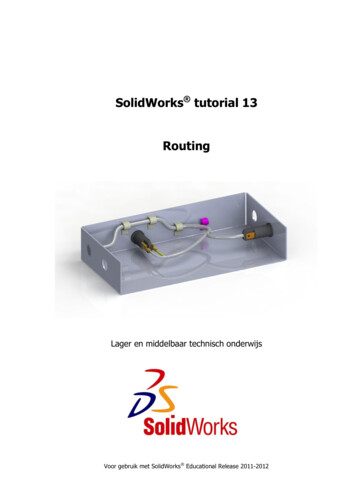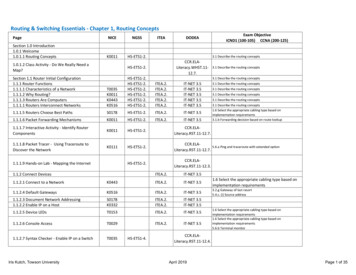
Transcription
Steiner RoutingECE6133Physical Design Automation of VLSI SystemsProf. Sung Kyu LimSchool of Electrical and Computer EngineeringGeorgia Institute of Technology
ARM A53 Placement1/11
TSMC 28nm BEOL VHM1M2M3M4M5M6RC(ohm/um) 809.050.177
Full-Chip RoutingM13/11M2M3
Full-Chip RoutingM44/11M5M6
M1 Layer (Mostly Intra-Cell Routing)yellow: signal5/11
M2 Layer6/11yellow: signalmagenta: clock, red: power/ground
M3 Layer7/11yellow: signalmagenta: clock
M48/11yellow: signalmagenta: clock
M59/11yellow: signalmagenta: clock, red: power/ground
M610/11yellow: signalcyan: power/ground
M7 and M811/11magenta: power/ground
RoutingplacementGenerates a "loose" route for each net.Assigns a list of routing regions to each net withoutspecifying the actual layout of wires.global routingGlobal routingdetailed routingFinds the actual geometric layout of each net withinthe assigned routing regions.compactionDetailed routing
Routing Constraints 100% routing completion area minimization, under a set of constraints:––––Placement constraint: usually based on fixed placementNumber of routing layersGeometrical constraints: must satisfy design rulesTiming constraints (performance-driven routing): must satisfy delayconstraints– Crosstalk?– Process variations?wsTwo layer routingGeometrical constraint
Graph Models for Global Routing: Grid Graph Each cell is represented by a vertex. Two vertices are joined by an edge if the corresponding cells are adjacentto each other. The occupied cells are represented as filled circles, whereas the othersare as clear circles.dabcadbc
Global-Routing Problem Given a netlist N {N1 , N2 , . . . , Nn}, a routing graph G (V, E), find aSteinerPn tree Ti for each net Ni, 1 i n, such that U (ej ) c(ej ), ej Eandi 1 L(Ti ) is minimized,where– c(ej ): capacity of edge ej ;– xij 1 if ej is in Ti; xij 0 otherwise;Pn– U (ej ) i 1 xij : # of wires that pass through the channel corresponding to edge ej ;– L(Ti): total wirelength of Steiner tree Ti. For high-performance, the maximum wirelength (maxni 1 L(Ti)) is minimized (or the longest path between two points in Ti is minimized).
Classification of Global-Routing Algorithm Sequential approach: Assigns priority to nets; routes one net at a timebased on its priority (net ordering?). Concurrent approach: All nets are considered at the same time (complexity?)global routing algorithmsequential approachtwo terminalline searchLeemazeHadlockmulti terminalSteiner tree basedSoukupconcurrent approachhierarchical integer programming
Data Structures and Basic AlgorithmsSpanning TreeProblem Formulation: Given a graph G (V E ), select a subset Vsuch that V has property P .0 V,0Minimum Spanning TreeProblem Formulation: Given an edge-weighted graph G (V E ), select a subsetof edges E E such that E induces a tree and thetotal cost of edges Pe E wt(ei), is minimum overall such trees, where wt(ei) is the cost or weight ofthe edge ei.0 0i20{ Used in routing applications.Algorithms for VLSI Physical Design Automation3.6cjSherwani 92
Data Structures and Basic AlgorithmsSteiner Trees1. Problem formulation:Given an edge weighted graph G (V E ) and a subset D V ,select a subset V V , such that D V and Vinduces a tree of minimum cost over all such trees.000 The set D is referred to as the set of demand points andthe set V ; D is referred to as Steiner points.0 Usedin the global routing of multi-terminal nets.A54D7C5666JB7E812296H 55I63F5GDemand Point(a)(b)Algorithms for VLSI Physical Design Automation3.13 cjSherwani 92
Min Spanning Trees vs. Steiner Trees Both problems try to “span” nodes in the given graph– Goal is to minimize the total edge weight– MST: span all nodes– Steiner tree: span only a designated subset of nodes. We can use “extra”nodes ( steiner nodes) if they help.
Data Structures and Basic AlgorithmsUnderlying Grid Graph The underlying grid graph is de ned by the intersections of thehorizontal and vertical lines drawn through the demand points.Hanan's Thm (69'):There exists anoptimal RST with allSteiner points (setS) chosen from theintersection pointsof horizontal andvertical lines drawnfrom points of D.Algorithms for VLSI Physical Design Automation3.14 cjSherwani 92
Data Structures and Basic AlgorithmsDi erent Steiner trees constructed from a MSTHwang's Thm (76'):The ratio of the costof a rectilinear MSTto that of an optimalRST is no greaterthan 3/2.(a)(b)(c)(d)(e)Algorithms for VLSI Physical Design Automation3.15 cjSherwani 92
Steiner Routing: 3D vs. 2Drouting problem instance3D Steiner Routing2D Steiner Routing Layer Assignment
The 1-Steiner Problem DefinitionRoutingPractical Problems in VLSI Physical CAD1-Steiner Algorithms
Why 1-Steiner Insertion? Can Reduce WirelengthRoutingPractical Problems in VLSI Physical CAD1-Steiner Algorithms
1-Steiner by Kahng/Robins Iterative 1-Steiner Insertion Algorithm Keep adding 1-Steiner point one-by-one until no more gainNaïve implementation: O(n2 n log n n)Sophisticated implementation: O(n3)RoutingPractical Problems in VLSI Physical CAD1-Steiner Algorithms
1-Steiner Routing by Kahng/Robins Perform 1-Steiner Routing by Kahng/Robins Need an initial MST: wirelength is 20 16 locations for Steiner pointsPractical Problems in VLSI Physical Design1-Steiner Algorithm (1/17)
First 1-Steiner Point Insertion There are six 1-Steiner points Two best solutions: we choose (c) randomlybeforeinsertionPractical Problems in VLSI Physical Design1-Steiner Algorithm (2/17)
First 1-Steiner Point Insertion (cont)beforeinsertionPractical Problems in VLSI Physical Design1-Steiner Algorithm (3/17)
Second 1-Steiner Point Insertion Need to break tie again Note that (a) and (b) do not contain any more 1-Steiner point: sowe choose (c)beforeinsertionPractical Problems in VLSI Physical Design1-Steiner Algorithm (4/17)
Third 1-Steiner Point Insertion Tree completed: all edges are rectilinearized Overall wirelength reduction 20 16 4beforeinsertionPractical Problems in VLSI Physical Design1-Steiner Algorithm (5/17)
Sample Kahng/Robins Routing (1/3) 5 points in 10x10 grid– 2 Steiner points usedMST (WL 21)final tree (WL 18)
Sample Kahng/Robins Routing (2/3) 50 points in 30x30 grid– 20 Steiner points usedMST (WL 183)final tree (WL 163)
Sample Kahng/Robins Routing (3/3) 100 points in 30x30 grid– 22 Steiner points used, it took 15ms to routeMST (WL 242)final tree (WL 220)
Kahng/Robins Speedup Techniques Random variant– Instead of choosing the best gain Steiner point in each iteration, just pickthe first one found.– Time spent on each step is less, but more Steiner points need to be added. Prune out bad candidates– After the first iteration, the Hanan grid points that gave no gain wereremoved.– This improved practical time complexity. Any other thoughts?
1-Steiner by Borah/Owens/Irwin Interesting ObservationRoutingPractical Problems in VLSI Physical CAD1-Steiner Algorithms
Gain Computation Things to do Thus, the gain isRoutingPractical Problems in VLSI Physical CAD1-Steiner Algorithms
Overall Algorithm Multi-pass Heuristic RoutingEntire algorithm can be repeatedPractical Problems in VLSI Physical CAD1-Steiner Algorithms
1-Steiner Routing by Borah/Owens/Irwin Perform a single pass of Borah/Owens/Irwin Initial MST has 5 edges with wirelength of 20 Need to compute the max-gain (node, edge) pair for each edge inthis MSTPractical Problems in VLSI Physical Design1-Steiner Algorithm (6/17)
Best Pair for (a,c)Practical Problems in VLSI Physical Design1-Steiner Algorithm (7/17)
Best Pair for (b,c) Three nodes can pair up with (b,c)l(a,c) l(p,a) 4 2Practical Problems in VLSI Physical Design1-Steiner Algorithm (8/17)
Best Pair for (b,c) (cont) All three pairs have the same gain Break ties randomlyl(b,d) l(p,d) 5 4l(c,e) l(p,e) 4 3Practical Problems in VLSI Physical Design1-Steiner Algorithm (9/17)
Best Pair for (b,d) Two nodes can pair up with (b,d) both pairs have the same gainl(b,c) l(p,c) 4 3l(b,c) l(p,e) 4 3Practical Problems in VLSI Physical Design1-Steiner Algorithm (10/17)
Best Pair for (c,e) Three nodes can pair up with (c,e)l(b,c) l(p,b) 4 3l(b,d) l(p,d) 5 4Practical Problems in VLSI Physical Design1-Steiner Algorithm (11/17)
Best Pair for (c,e) (cont)l(e,f) l(p,f) 3 2Practical Problems in VLSI Physical Design1-Steiner Algorithm (12/17)
Best Pair for (e,f) Can merge with c onlyl(c,e) l(p,c) 4 3Practical Problems in VLSI Physical Design1-Steiner Algorithm (13/17)
Summary Max-gain pair table Sort based on gain valuePractical Problems in VLSI Physical Design1-Steiner Algorithm (14/17)
First 1-Steiner Point Insertion Choose {b, (a,c)} (max-gain pair) Mark e1 (a,c), e2 (b,c) Skip {a, (b,c)}, {c, (b,d)}, {b, (c,e)} since their e1/e2 are alreadymarked Wirelength reduces from 20 to 18Practical Problems in VLSI Physical Design1-Steiner Algorithm (15/17)
Second 1-Steiner Point Insertion Choose {c, (e,f)} (last one remaining) Wirelength reduces from 18 to 17Practical Problems in VLSI Physical Design1-Steiner Algorithm (16/17)
Sample Borah Routing 100 points in 30x30 grid– 22 Steiner points used, it took 59ms to routeMST (WL 242)final tree (WL 219)
Comparison Kahng/Robins vs Borah/Owens/Irwin RoutingKahng/Robins tends to give better resultsBorah/Owens/Irwin runs much faster: O(n4 log n) vs O(n2)Practical Problems in VLSI Physical CAD1-Steiner Algorithms
Bounded Radius Routing Why Radius? Both Radius and Cost? Longest source-sink path length among all sinksSmaller path resistance: better performanceCost wirelengthRadius ( R) and wirelength ( C) are both important for RCdelay reductionBounded PRIM vs Bounded Radius/Cost RoutingJ. Cong, A. B. Kahng, G. Robins, M. Sarrafzadeh, and C. K.Wong, "Provably good performance-driven global routing",TCAD, 1992.Practical Problems in VLSI Physical CADBRBC Algorithm
Radius vs WirelengthRoutingPractical Problems in VLSI Physical CADBRBC Algorithm
BPRIM Under ε Radius bound regular PRIMPractical Problems in VLSI Physical DesignBounded Radius Routing (9/16)
BPRIM Under ε (cont)Practical Problems in VLSI Physical DesignBounded Radius Routing (10/16)
Bounded PRIM Algorithm Variation of PRIM’s MST algorithmRoutingPractical Problems in VLSI Physical CADBRBC Algorithm
Why Tighter Radius? BPRIM uses tighter radius bound during backtracing– R instead of (1 e)R
Bounded PRIM Algorithm Comparison (e 0, 0.5, infinity) RoutingRadius bound/value increaseWirelength decreasesPractical Problems in VLSI Physical CADBRBC Algorithm
Bounded Radius Routing Perform bounded PRIM algorithm Under ε 0, ε 0.5, and ε Compare radius and wirelength Radius 12 for this netPractical Problems in VLSI Physical DesignBounded Radius Routing (1/16)
BPRIM Under ε 0 (cont)Practical Problems in VLSI Physical DesignBounded Radius Routing (4/16)
BPRIM Under ε 0 (cont)Practical Problems in VLSI Physical DesignBounded Radius Routing (5/16)
BPRIM Under ε 0.5 (cont)Practical Problems in VLSI Physical DesignBounded Radius Routing (7/16)
BPRIM Under ε 0.5 (cont)Practical Problems in VLSI Physical DesignBounded Radius Routing (8/16)
Comparison As the bound increases (12 18 ) Radius value increases (12 17 22) Wirelength decreases (56 49 36)Practical Problems in VLSI Physical DesignBounded Radius Routing (11/16)
- Instead of choosing the best gain Steiner point in each iteration, just pick the first one found. - Time spent on each step is less, but more Steiner points need to be added. Prune out bad candidates - After the first iteration, the Hanan grid points that gave no gain were removed. - This improved practical time complexity.
